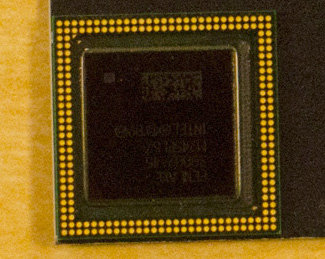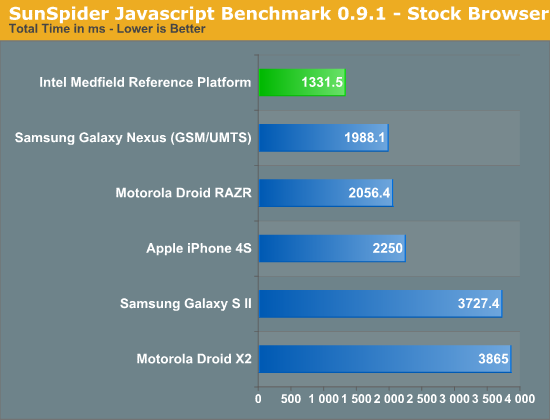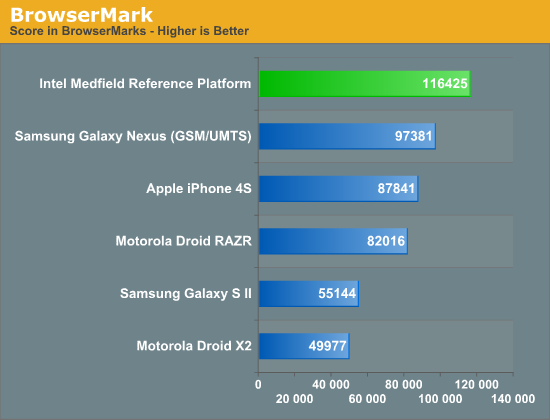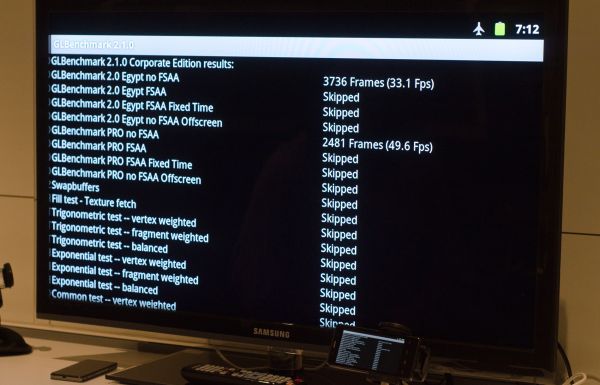Intel's Medfield & Atom Z2460 Arrive for Smartphones: It's Finally Here
by Anand Lal Shimpi on January 10, 2012 8:00 PM ESTIt's here. Intel's first smartphone SoC that you'll actually be able to buy in a device before the end of the year. The platform is called Medfield and Paul Otellini just announced its first device partners.
Medfield starts out as a bonafide mobile SoC. Whereas Moorestown was a "two-chip" solution, Medfield is just one - the Penwell SoC:

The SoC is only available in a PoP (Package on Package) configuration measuring 12mm x 12mm. Intel wouldn't give out a die size but it did show me a Penwell sample without the stacked DRAM:

Since I know the measurements of the package I could estimate the dimensions of the silicon itself. My math worked out to be around 62mm^2. That's larger than a Tegra 2-class SoC, but smaller than Tegra 3 or Apple's A5. The diagram of its high level architecture above helps explain why.
There's only a single version of Medfield being announced today: the Intel Atom Z2460. The Z2460 features a single Atom core with a 512KB L2 cache, a PowerVR SGX 540 GPU and a dual-channel LPDDR2 memory interface. In a world where talking about four Cortex A9s and PowerVR SGX 544MP2s isn't uncommon, Medfield starts out almost sounding a bit...tame. But then you see its performance:

Although running what appears to be a stock Gingerbread browser, Intel's Medfield reference platform posts SunSpider performance better than any other smartphone we've tested - including the Galaxy Nexus running Ice Cream Sandwich. Intel promises that Medfield's performance will scale on ICS as well - the gap should be maintained. We've seen high results from reference designs in the past, but the Medfield platform is a little different as you'll soon see - it's a complete smartphone design that should be representative of handsets that hit the market later this year.
Medfield isn't a one trick pony either, performance is similarly dominating under BrowserMark:

These are tablet-like scores. Here the Galaxy Nexus running ICS comes close, but once again Intel expects that on the same OS Medfield should be faster than any of the currently available SoCs.
I asked Intel where its SunSpider and BrowserMark performance advantages came from, especially considering we've typically only seen huge gains with new browsers and not new SoCs. Their response pointed to a bunch of factors, but one stand out issue was the A9 has a great execution core but seems to be more limited on the memory interface. Atom can support far more outstanding misses in L2 than the Cortex A9, which chokes bandwidth to the processor for anything not already in the L2 cache. This may be one of the reasons why we've never been able to get really high bandwidth numbers out of A9 based SoCs. It's probably safe to assume that things will be different with the Cortex A15, but for now it's little things like this that give Medfield a performance advantage.
GPU performance is understandably not as impressive. We couldn't get offscreen numbers of GLBenchmark 2.1 but we did get results at the device's native resolution (1024 x 600):
3D performance is better than the OMAP 4460 due to Medfield's 400MHz GPU clock compared to ~300MHz in most OMAP4 devices.
Performance without power considerations is meaningless, especially in the smartphone world. Luckily for Intel, Medfield seems very competitive there as well. Intel provided some power and performance data for Medfield based on its reference platform. I still haven't been able to verify any of this for myself, but I was able to see some power tests run in person on the reference platform and competitive devices.
The Intel provided values are pretty astonishing . Sub 20mW idle, sub 750mW during a call on 3G and although not pictured here, Intel's internal data suggests ~1W power consumption while browsing the web compared to ~1.3W on the iPhone 4S and Galaxy S 2. I've done my own measurements on 4S web browsing and came up with a very similar value.
| Intel Measured Smartphone Power Consumption (Identical Display Brightness) | ||||||
| Standby (3G) | Talk (3G) | Browsing (3G) | Video Playback 720p | |||
| Apple iPhone 4S | ~38mW | ~800mW | ~1.3W | ~500mW | ||
| Intel Medfield Reference | ~18mW | ~700mW | ~1.0W | ~850mW | ||
| Samsung Galaxy S II | ~19mW | ~675mW | ~1.2W | ~650mW | ||
The performance and power data both look great for Medfield. You would think that this data, assuming there's nothing fundamentally wrong, would be enough to convince a handset maker to actually give Intel a shot. You'd be right.
In addition to disclosing Medfield performance data, Intel is also announcing partnerships with both Motorola and Lenovo. The former is a broad, multi-year agreement stating that Motorola plans on creating many devices based on Intel silicon - the first of which will be a smartphone due out before the end of the year. Tablets will follow at some point as well.
Lenovo on the other hand will actually be taking and tweaking Intel's own Medfield reference platform, and releasing it in China in Q2.
All of this is exactly what Intel needed: a start.











164 Comments
View All Comments
stadisticado - Wednesday, January 11, 2012 - link
I think dealcorn is being a bit hyperbolic. That said, even 'competitive' from Intel has to be a big warning sign for sellers of ARM chips.dealcorn - Wednesday, January 11, 2012 - link
I may be wrong and this will be measured by independent observers in due course, but I had no intent of being hyperbolic.If you look at the investor' chart on the first page of the article (where Anand says he knows who they are and what the power ratings are) Medfield ranks first in performance on all 3 tests. On economy it scores 2/6 twice and 3/6 once. When I look at how much they won by and how much they did not win by, my visual computer says "superior". Look at the pictures yourself and exercise your own judgment.
aury - Wednesday, January 11, 2012 - link
"intel did it"Uhm, you might like to show some side by side comparisons of that phone next to an actual phone instead of just the front.
The phone is about twice as thick as a normal phone, it has actual heat disappating sections, which means the chip is likely much hotter than an A9.
All the tests you show are the same ones intel shows on their CES pamflet, i.e. they are freaking useless, since they wouldn't put tests up there that didn't show them at an advantage.
This is not "intel did it", not by a long shot.
Anand Lal Shimpi - Wednesday, January 11, 2012 - link
iPhone 4S thickness: 9.3mm, Medfield reference design thickness: 9.5mm.There's apparently a thinner version but I don't believe the form factor is the issue anymore.
Take care,
Anand
jjj - Wednesday, January 11, 2012 - link
I wouldn't trust Intel data but we'll see,waiting eagerly for real products and real tests,just wish you were more objective when it comes to Intel.The ref platform is rather fat and the battery smaller than what most high end smartphones have so i wouldn't call it sweet.
The partnerships are ,hmm,rather interesting.Lenovo is not exactly a phone maker and while they might shift some volume in China they are not the ideal partner (and they can be payed off with some price cuts and marketing $). Moto AKA Google might have other reasons to do this. Samsung is starting to be too big and Intel competing in this space might slow them down somewhat and Google has no interest in not beeing present on x86 when they scale Android up so another favour after the Google TV deal would not be out of the question.Also with the Moto deal,Intel hurt Nvidia since they are the ones that got kicked out to make room for Intel.
At least ,if the numbers are even somewhat close to reality they could have a good product on 22nm.
aury - Wednesday, January 11, 2012 - link
What people also don't seem to understand is that Intel doesn't need something equal to ARM, it needs something better for anyone to turn an eye.Phone manufacturers control the whole supply line from A to Z when making a phone, it's not like PCs where different manufacturers control different supply line.
Phone makers will not easily switch or change their supply lines, they are locked into huge deals and contracts and unless you offer them something with amazing benefits, they will not change.
Intel offers nothing, they are high cost, they are way behind ARM in power efficiency, they ***** off Nvidia, they **** off qualcomm, they are a direct competitor to Samsung, and this chip is a joke if it will be released by the end of the year, that's why the only partner they have atm is lenovo, because it's a PC manufacturer.
Penti - Wednesday, January 11, 2012 - link
Actually Intel controls plenty and can offer a complete platform. That's more then Apple (Qualcomm and Intel Baseband) or Samsung (Qualcomm and others baseband modems regardless if it is their own Exynos SoC). Neither are they trying to win over Apple. All other manufacturers are totally free from building major hardware / silicon. That is LG, Sony (ex-SE which aren't using ST-E or former Ericsson basebands since a long time), Nokia, HTC, Huawei, ZTE, Motorola Mobility/Google, Hitachi, Fujitsu, Sharp, Panasonic, NEC, Pantech, Research In Motion and more has no semiconductor business connected to application or baseband processors today. That they don't offer SoC IP at foundry level won't matter much here. Neither are they unmovable on the parts. Specially not if they have a good reference platform and BSP/driver-package ready and working. They also have multiple hardware partners and Intel don't expect that to disappear. They were driving those players to ARM to begin with when they had their own architecture.Most turn to companies like TI, Qualcomm, Samsung (Application processor), Freescale, Nvidia (no baseband integration yet or any baseband platform) for chips. Most need to do more engineering then to buy a platform that is ready. It's certainly not PC's. Intel got thousands of ex-Infineon people building baseband and GPS chips and they know the business.
french toast - Wednesday, January 11, 2012 - link
Thers a big alliance already betweem japanese docomto and samsung, and a few other to develop in dies 4g modems. st erickson and qualcomm already provide this service and will be shipping actual phones with this tech inside this year..not 'sometime in 2013'.The reason why manufacturers have gone ARM is not only because they offer better performance and better power levels, they are also cheaper to produce and buy, they also have the option of a quick turn around for specialist designs, or they can design a processor to there own design.
Either medfoeld is going to be sold break even, or its goig to be twice the cost of ARM designs, that are bith more powerfull and power efficient.
Penti - Wednesday, January 11, 2012 - link
On-die baseband hasn't meant that much, regarding custom designs we can see that Apple hasn't gone that route. It hasn't made much sense to force everything into a single chip. It's a nice feature that often doesn't get implemented in actual products and ST-E and Qualcomm haven't and most will not have fully contained LTE-basebands integrated into their SoC this year. Still requires external hardware. You still require application processor, baseband processor, wifi chipset, bluetooth chipset, audio dac, nand memory, display ics, radio hardware (RF IC, RF transceiver) outside of the baseband processor and so on. At least on most Samsung, Freescale, TI, Nvidia and so on hardware. Intel can still put together and market a great single-chip LTE-baseband to compete. That they can't compete in the embedded space is a whole different thing. They are not strong in the automotive field to begin with so why would they try. For mobiles it's all about platform not synthesized IP-blocks. They are still a chip provider the same way as their competitors are when it comes to smart phones.NTT DoCoMos joint venture with Fujitsu, NEC, Samsung, Panasonic and Fujitsu semiconductor don't matter much here it's still a independent modem not an integrated one. Neither should they have much of chips to put out this year as it won't even form until March. Those modems can be used with any application processor. So can baseband modems from Broadcom, Intel, Qualcomm, Altair, ST-Ericsson, Cavium, Sequans and many more.
It is depending on much more how big and complex the actual platform is in a circuit board of a phone or tablet. Remember here that the Intel also has only PoP memory while most do external on board LPDDR(1/2). I'm sure it can be paired with hardware to make it no bigger then much of any competitors. Bom doesn't need to be several times of the competitors, I'm sure it isn't. Neither does it need to compete with none existing 2013 hardware. A SoC like this doesn't cost Intel many dollars to produce. It won't erase everything and outdo everybody but it is good enough for some of the major vendors to try it in some of their models (obviously Android handsets and Tablets).
french toast - Thursday, January 12, 2012 - link
Im sorry, although this isnt an area that i have a huge amount of knowlege on, i can say with some certainty that both Qualcomm and ST-E will have on die baseband shipping this year on 28nm, In qualcomms case the s4 processor that is being demoed with the Asus idea pad has one in.I can also say it has 2 main advantages that i know of (and likely many more that i dont)
1) When put on die and using the same process as in qualcomm and ST-E case it vastly improves power effiecency, a big problem with currant 4g.
2) As most of the components are included on die that you have mentioned, that means more space out side of the die, less hastle for the manufacturers and more space inside the device/phone for things like battery/or smaller device.
Regards to Apple, apple bought PA semi, back in 2007/08 and use it to design its A-series chips, whilst it hasn't used a complete custom licence, they have done some soft optimisations, im not privvy to what they are.
Samsung also acquired intrinsity around the same time, and used their custom logic to some minor power improvements to the cortex core..first seen on the hummingbird..as Apple uses samsung to manufacture there chips, you can bet some of that is licenced too.
Qualcomm ,nvidia (not tegra)and Marvel also have full custom license.